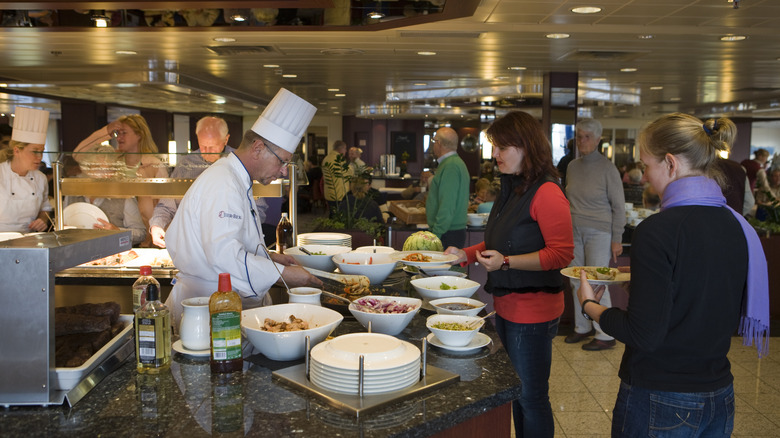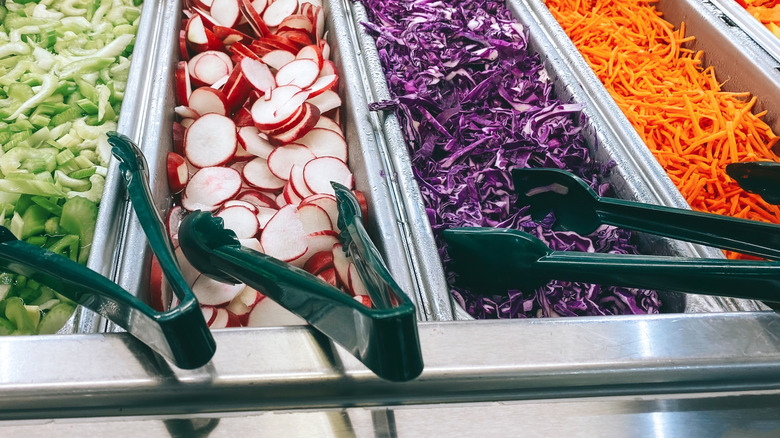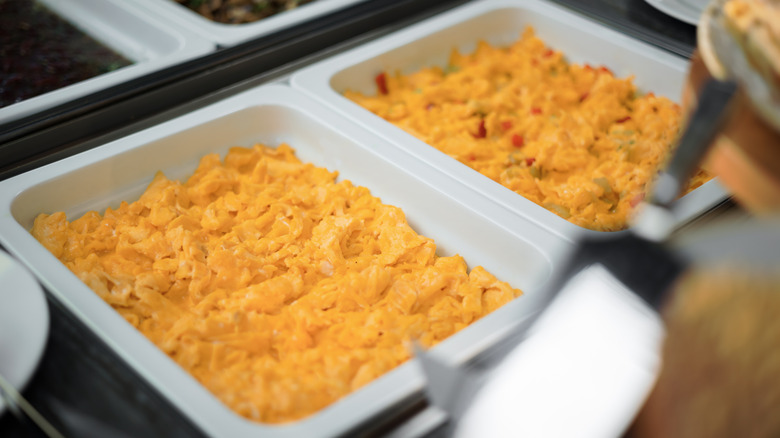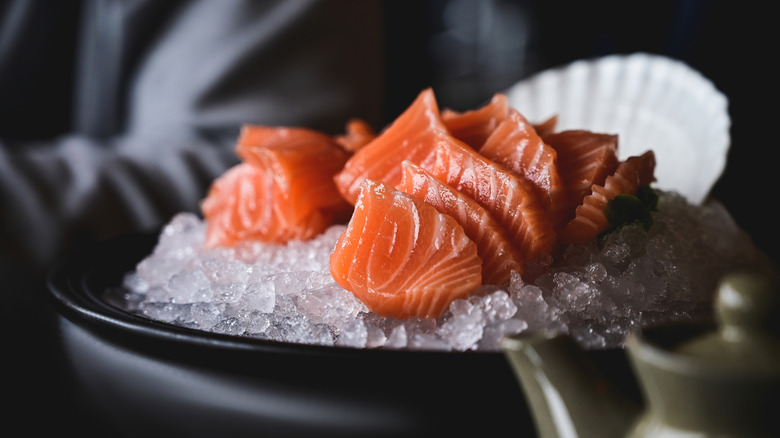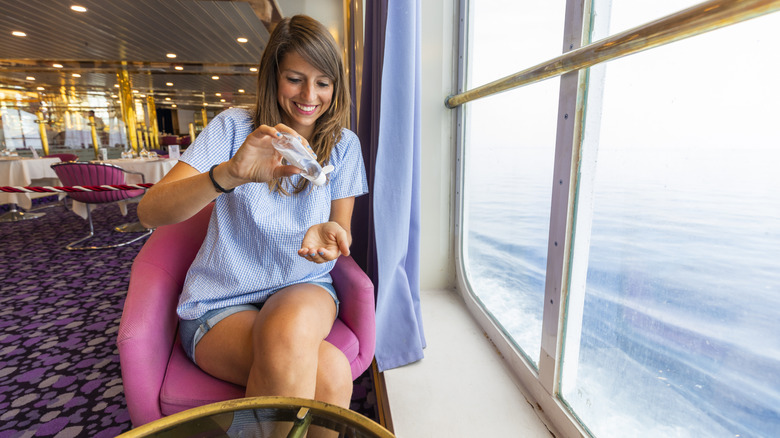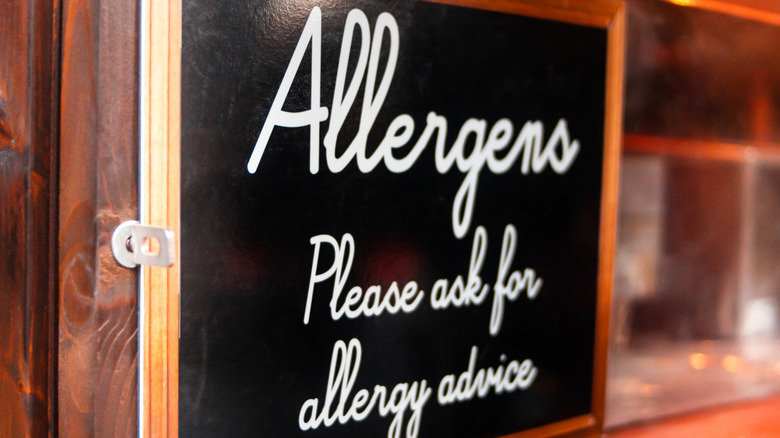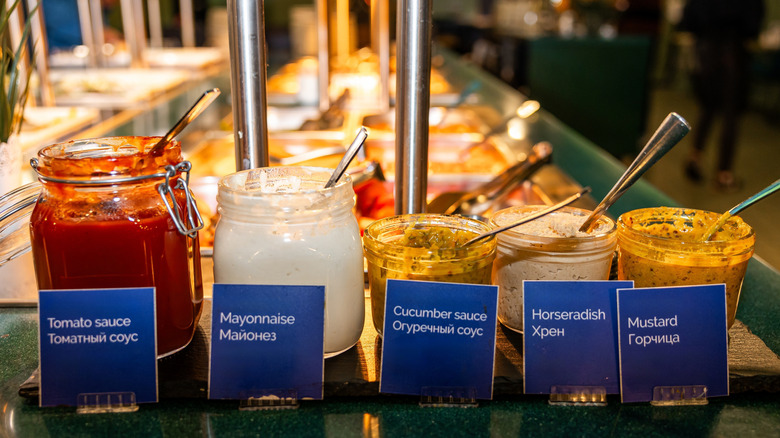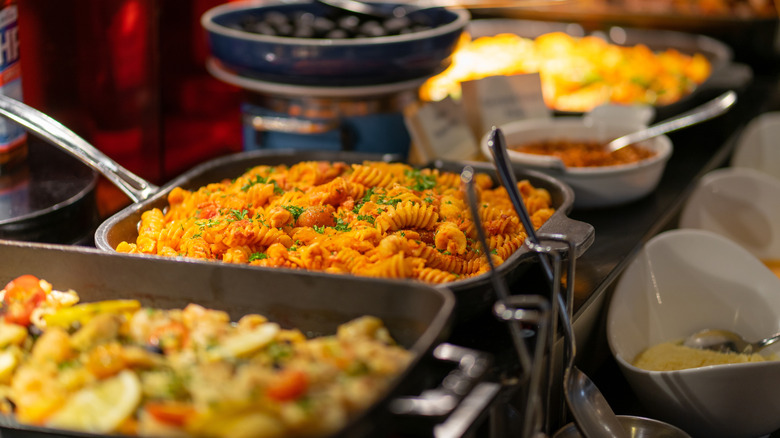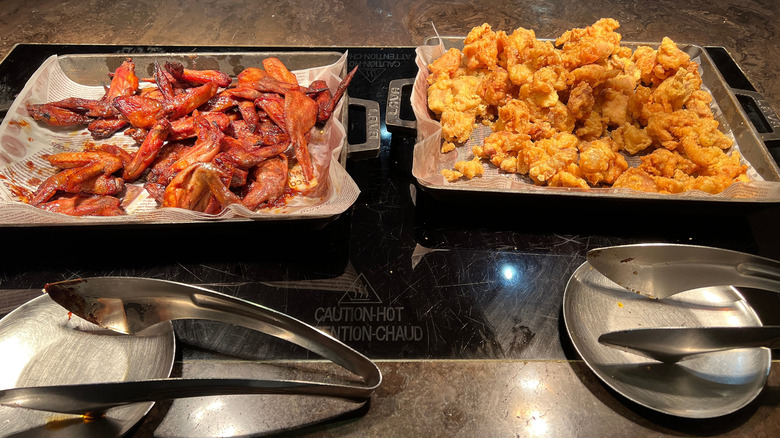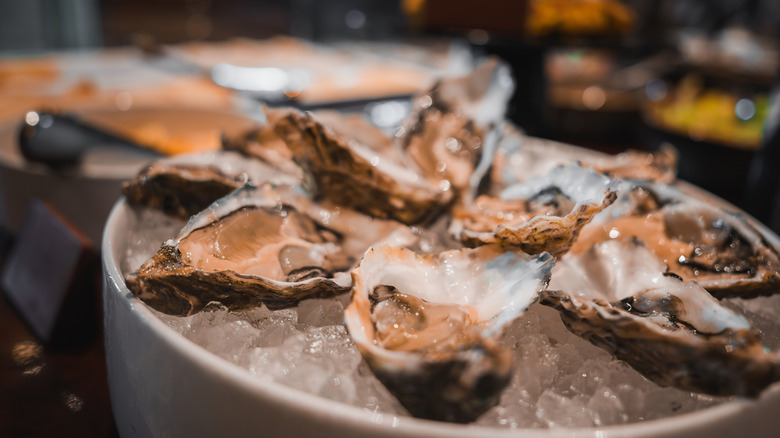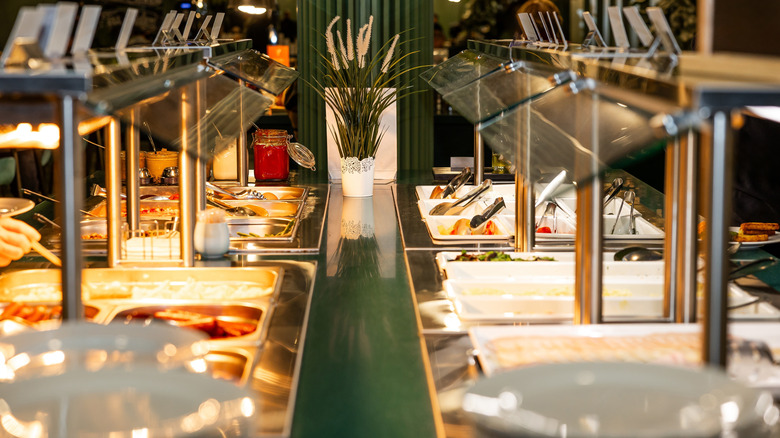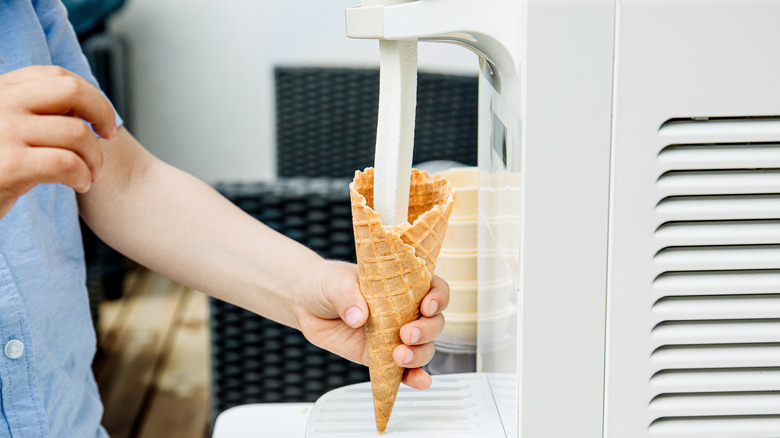14 Red Flags To Look Out For At A Cruise Ship Buffet
Few things are as hands-off as a holiday on a cruise ship. It's a time when you leave your troubles and worries at home, and kick back in the middle of the ocean with a cocktail in your hand. Something else you leave at home is cooking, with dining on a cruise normally focused around the enormous, delicious buffets catering to your every taste. What you shouldn't forget to bring, however, is a critical eye. These buffets may have a wide variety of food, but their quality can vary considerably — and red flags can present themselves at every turn.
These red flags may point towards the buffet's food potentially not being as fresh or tasty as you might like, but they can also signpost something a little more serious. There's no worse place to be sick than on a cruise ship, and while the likelihood of becoming ill when at sea is actually lower than at home, the close-quarters environment and lack of escape can make viruses run rampant amongst passengers. There's no better way to avoid getting sick onboard than keeping an eye on hygiene standards, and it all starts at the buffet. Wash your hands, grab your plate, and let's get started.
1. The pizza looks congealed
Pizza is a truly unifying food, especially in environments where you're not sure about the other grub on offer or where your kids are in tow. While we may all enjoy the pizzas at a buffet, though, it's worth taking a closer look at what they look like. Pizza that looks noticeably congealed or slightly dry has likely been sitting out for a while. If it's under a heat lamp, it may not pose any risk of food poisoning, but it's fair to say that you won't be getting the freshest bite of pizza possible. If the pizza isn't fresh, what else is this buffet hiding?
It also pays to take a look at the pizza's crust. If it looks dry, chalky, or slightly burnt at the edges, then there's a good chance that it was cooked a while ago and the heat lamp it's been sitting under has dried it out. Instead of putting up with a substandard slice, simply ask the staff if they're planning on preparing a new pizza any time soon. If you're really craving some pizza and they say that a new one's going to be a while, there's a high likelihood that your cruise ship will have a restaurant that sells it somewhere.
2. The serving utensils look grubby
Serving utensils at buffets are among the most unhygienic things you can touch — which makes things pretty difficult, given that you need them to serve yourself food. The problem with serving utensils at buffets is that everyone touches them, and you have no idea what other people's hygiene is like. They may not have washed their hands after going to the bathroom, may have just touched something that has bacteria on it, or they may be suffering from a cold or flu themselves. Add to that the fact that buffet staff may not have swapped out those utensils throughout the entire food service, and you're in real trouble.
Unfortunately, there's no good way to avoid using the utensils other than bringing your own to the buffet, and we're willing to bet that you didn't pack tongs and a serving spoon. So, it's time to get creative. Grab a couple of tablespoons and forks from the cutlery area, and use them to serve yourself; sure, it may look a bit strange, but it's better than getting sick. If that's not an option, bring some hand sanitizer with you to the buffet, and make sure to sanitize your hands before and after using the serving utensils and before you start eating.
3. The eggs look especially wet
Scrambled eggs are a fixture on virtually every breakfast buffet around the world, and it's no different on cruise ships. Unfortunately, though, a big breakfast buffet red flag is wet, gloopy-looking eggs. Particularly wet-looking eggs are a definite sign that they've been made from powdered eggs instead of fresh ones. While fresh eggs tend to become nice and firm when they're cooked, scrambled eggs made from powdered eggs remain pretty liquified, even when they've been sitting under a heat lamp for a while.
Cruise ships tend to use powdered eggs instead of fresh ones because they're cheaper, easier to transport, and can stay edible for way longer than the hen-laid version — which is a must when you're spending weeks at sea. On a hygiene level, there's absolutely nothing wrong with powdered eggs, but it's commonly agreed that they're not as good as the fresh kind, and it could be a sign that the cruise ship you're on is cutting corners elsewhere. Rather than put up with these eggs, see if you can find an omelet station at the buffet. These are a pretty common feature, and are a good way to guarantee you're getting the fresh stuff.
4. The sushi isn't kept on ice
Piling sushi onto your plate at a cruise ship buffet is a good way to play with fire, but it's not strictly true that it's always going to make you sick. If the sushi is freshly made and displayed properly, it could well be delicious and safe to eat. If there's any doubt whatsoever that the sushi on display is unsanitary, though, you should give it a wide berth — and one of the biggest red flags is if it isn't being kept on ice.
The problem is that when raw food like sushi isn't kept below 40 degrees F, things can go wrong pretty quickly. Any warmer than that and your food enters the "Danger Zone" of temperatures in which foodborne bacteria can flourish. Keeping sushi on ice or in a temperature-regulated display cabinet can ensure that it's cool enough to stay safe, but even then, you can't be 100% sure that it will be. You don't know how that sushi's been prepared or kept in the kitchen, and it may have only recently been chilled. Just because you're in the middle of the sea, doesn't make it safe, folks.
5. Your fellow passengers aren't sanitizing their hands
Next time you're at the cruise ship buffet, take a good look around you. What are your fellow passengers doing? Are they employing the use of the sanitation stations that are dotted around, and cleaning their hands regularly? If not, you might be in trouble. Passengers failing to sanitize their hands is one of the biggest bugbears that cruise ship workers have to deal with. It's hardly any surprise, given that poor hygiene and sanitation can massively raise the risk of illness spreading.
The reason this is a major red flag, though, is because it could be a sign that your cruise ship isn't investing enough energy in asking customers to sanitize their hands before they eat. If they're not doing that, then it could be a sign that things are being missed elsewhere, or the employees on board haven't been told to do so by management. Asking all your fellow passengers to sanitize their hands obviously is not going to make you very popular on the ship, so if you notice a lack of sanitation happening, it's best to mention this to a member of staff.
6. The allergen information isn't clearly displayed
An allergic reaction on a cruise ship is hugely dangerous. While major cruise ship companies will have medical staff on board and on call at all times, they're naturally limited by the sheer inability to draw on any resources other than those on the boat. As such, ensuring that any allergens are kept to a minimum and are clearly displayed is utterly crucial — and if your cruise ship buffet isn't displaying theirs, that's a serious warning sign.
Ideally, allergen information should be displayed above or next to each dish, using allergen icons or prominently displayed written warnings. There should be no ambiguity about which dish contains which allergen. Additionally, utensils used to serve food that contains allergens should be kept separate from all the others, to avoid the risk of cross-contamination. If the buffet doesn't have their allergen information displayed clearly and visibly, ask a member of staff if they have an information sheet on the food being served, so you can discern exactly what's in each dish. If there's no info available, it's a big sign that this cruise doesn't care about the safety of its customers.
7. The condiment area is messy
Many cruise ship buffets will have a dedicated condiment area, with a lot of them having several dotted about which correspond to the different foods being served. Next time you're ladling sauces and dips onto your plate, take a minute to assess how clean that condiment area actually is. Condiments are some of the highest-traffic items at buffets, with dozens of people picking up their bottles and serving spoons during every service. If the condiment area's hygiene standards aren't being properly maintained and things feel messy and dirty, it's a good sign that the staff have forgotten to clean it, raising the risk of bacteria lurking around the area.
Where possible, it's a good idea to avoid using these communal condiments entirely. Instead, try to seek out some sachets. Condiment sachets are by far the most sanitary form of getting your sauces, as they're single servings and unlikely to have been handled by many people. If the buffet doesn't have any sachets, make sure you sanitize your hands well after you add any condiments to your plate to avoid cross-contamination.
8. The buffet is pushing certain items
While a lot of us arrive at the buffet ready to start piling our plates high, it's good to take a beat before doing so. Next time you enter the cruise ship buffet, take a walk around and see what's available. Do you notice that the buffet has several tureens containing one item, or particular things are displayed more prominently than others? Conversely, does the buffet have ready-made items, like pasta, noodles, or carvery meats, that you can also get at a live station somewhere else in the room?
If there are either of these, it might be best to avoid them. Unless your buffet is genuinely pushing something as a special, it could be the case that they're trying to get through leftover food stock before it goes bad — and so those items may not be as fresh as others. Plus, when it comes to those live stations, you can guarantee that what they make will taste better than the equivalent dishes sitting dotted around the buffet. Sure, they may take a bit longer to make, but you'll reap the rewards when you're eating.
9. The same food has been sitting there for hours
If you're sitting somewhere at the buffet with a good view of the food, cast your eyes over now and again. Have you noticed that one specific dish has been sitting there for a while? If so, this could be a red flag about the freshness of the buffet's food. Cruise ship buffets are usually pretty good about rotating their stock, but when the same food's been sitting there for hours, it'll become dry, unappetizing, and potentially unsafe. It's particularly useful to pay attention to lower-traffic areas of buffets, which can also often be the spaces where the food isn't temperature-controlled. If these foods are sitting out for more than two hours at room temperature, they're way more likely to be unsafe to eat.
While it benefits all buffet owners to stretch their stock for as long as they can, it naturally benefits cruise ships to do so a little more. Their employees can't run out and get replacement items from the nearest store if they run out, after all — they have to make what they have onboard last. However, that shouldn't be a reason for food that's past its prime to be sitting there for customers to eat. Keep a watchful eye, and don't be afraid to ask how long specific items have been left out.
10. The oysters are raw
Going on a cruise is a good excuse to be a little bit fancy, and that can extend to your buffet choices. We'd recommend that you don't wait until you hit the cruise ship buffet to try oysters for the first time, though — especially if they're raw. There's a lot to be aware of when eating oysters at a restaurant, but at a buffet, raw oysters are especially dangerous due to their potential to be carrying Vibrio bacteria. This bacteria builds up in the oysters as they filter food particles out of the water around them, and it can cause an infection called Vibriosis.
That's an illness you definitely don't want. Vibriosis is a form of food poisoning, and while most people only exhibit mild symptoms like diarrhea and vomiting (which still aren't very fun), it can also cause severe illness and potentially death. The only effective way to prevent Vibriosis is by cooking oysters properly, which kills the bacteria. If you do decide to risk it with raw oysters, ensure that they've been thoroughly chilled and are being displayed on ice. Keeping them at room temperature only heightens the risk of them causing food poisoning.
11. The potato salad is looking a little slimy
The salad bar at a cruise ship buffet is a welcome respite from the heavier dishes, and a chance to grab something a little lighter to cleanse the palate. Next time you're there, though, take a look at the potato salad. If it's looking a bit shiny, slimy, or giving off a sour smell, it's definitely one to skip. Potato salads are one of the foods you should avoid at a buffet, and are notorious for being susceptible to bacteria that cause spoilage and food poisoning. Interestingly, though, it's probably not the mayo that causes a potato salad to spoil. Instead, the potatoes can reduce the overall acidity of the dish and create an environment that promotes bacterial growth.
It's also useful to stay critical of all the other dishes at the salad bar. Is there a sneeze guard? Are they being kept at a cool temperature, or being allowed to gradually warm? How clean does it look? All of these questions need to be asked, as salads are generally a little neglected at buffets and can therefore be more prone to developing foodborne bacteria.
12. Other passengers are picking up food with their hands
Okay, so we very much recognize that you can't police the other guests at the cruise ship buffet, and nor would you want to. You're on holiday, after all. However, if you're noticing that people at your buffet are picking up food with their hands, it might be worth politely mentioning it to a member of staff. Picking up food with bare hands at a buffet is one of the quickest ways to sully food, and potentially spread foodborne illness. Even if you don't touch any other items when picking up the food, you run the risk of nudging or knocking things, which can cause bacteria to spread.
A gentle word to the catering staff may help to prevent the issue further — they can implement measures to stop people handling the food, either by speaking to them individually or by placing more signage up around the buffet. If the issue is that they didn't want to use dirty utensils, then flagging this can alert the staff that they need to change those more regularly.
13. You see people sneezing or coughing around the food
People being ill on holiday is never fun, but when you're on a cruise ship, sickness can be way more high stakes. You don't want to come down with something when you have nowhere to escape to but your cabin, after all — you're there to enjoy yourself! This means it's important to keep a lookout for people sneezing or coughing around the food at the buffet. Not only will avoiding them help prevent you from getting sick, but it'll also prevent you from picking up food that they may have coughed or sneezed on, and potentially covered in bacteria.
If you see this, it's always worth letting a member of staff know. They may be able to implement protective measures to increase the level of hygiene around the buffet, putting out sneeze guards and making sanitation stations more prominent. Remember, though, that you should practice what you preach on this one too. If you're sick, you should avoid the buffet until you're feeling better.
14. The buffet has a soft-serve machine
Soft serve machines are definitely way more fun than trying to scoop ice cream out of rock-hard tubs, and a good way to guarantee that your dessert is as fresh as can be. When you're on a cruise ship, though, you should probably skip the soft serve. Think about it: In a single food service, dozens of people can be using this machine, each of them grabbing the lever and pulling it with potentially dirty hands. Any bacteria that makes its way onto the handle will then transfer to your own hands, then to your bowl, and then to your mouth.
It's also useful to remember that one of the more unsettling facts about soft serve machines is not that their outside is dirty — it's that their insides can be even worse. Soft serve machines are notoriously difficult to clean, which can lead to a build-up of bacteria inside them that then transfer to the dish itself. While fast food employees can be well-versed in cleaning them thoroughly, cruise ship employees may not be following the same standards. The short windows between lunch and dinner services at cruise ship buffets may also limit the time they have to clean the machine.
